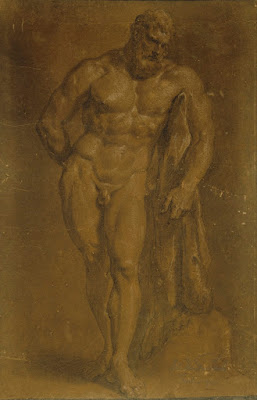 |
| follower of Leonardo da Vinci Study of an Antique Statue ca. 1490-1520 drawing Musée du Louvre |
 |
| attributed to Marcantonio Raimondi Antique Statue in Niche before 1527 drawing Musée du Louvre |
 |
| Bartolomeo Passarotti Study after Antique Sculpture before 1592 drawing Musée du Louvre |
 |
| John Vanderbank Cast of the Farnese Hercules 1732 drawing Royal Academy of Arts, London |
 |
| Louis-Claude Vassé Studies of an Antique Hermaphroditus before 1772 drawing Musée du Louvre |
 |
| George Romney Horse Tamer of Montecavallo, Rome ca. 1773-74 drawing Yale Center for British Art |
 |
| William Hamilton Study of the Farnese Flora ca. 1785 drawing Royal Academy of Arts, London |
 |
| Gavin Hamilton Antique Statue of a Young Woman 1792-93 drawing Royal Academy of Arts, London |
 |
| John Gibson Figure of Dionysus from the East Pediment of the Parthenon (Elgin Marbles) ca. 1816 drawing Royal Academy of Arts, London |
 |
| George Richmond Figure of Ilissos from the West Pediment of the Parthenon (Elgin Marbles) 1824 drawing Royal Academy of Arts, London |
 |
| George Richmond Cast of the Apollo Belvedere 1824 drawing Royal Academy of Arts, London |
 |
| John Everett Millais Cast of the Apollo Belvedere 1841 drawing (made at age 12) Royal Academy of Arts, London |
 |
| John Everett Millais Cast of the Marble Faun ca. 1844 drawing Royal Academy of Arts, London |
 |
| Charles West Cope Cast of the Discobolus 1828 drawing Royal Academy of Arts, London |
 |
| Margaret E. Wilson Cast of the Farnese Hermes ca. 1912 drawing Royal Academy of Arts, London |
 |
| Margaret E. Wilson Cast of the Dancing Faun ca. 1912-16 drawing Royal Academy of Arts, London |
from Six Further Studies
I
In heaven there is no more sea, and houses no longer need a widow's walk. And no more widows, there being neither marriage nor giving in marriage. How the air hangs lower and lower on this – I hope – hottest day of summer. A faintly rotten scent the ground gives off brings to mind lilacs that have budded and blossomed. There are no more blossoms, perfume and purple gone for a year, as if forever. In heaven there are no tears, salt water wiped away entirely. One moment I breathe contentment. And then unreasoning sorrow pulses through me, an imperfect tension, as if unending. I have time on my hands. In heaven there is no more dusk, dark, dawn, meridian. And what I know now and for certain: neither the day nor the hour.
II
It seems clear enough that there is in the brain a particular pain-center, where sensations of every variety check in, to emerge as anguish or hurt. Thus there is not, as we might suppose, a multiplicity of pains, like an arsenal deployed against us, but one pain which puts on, as in a ritual theater, different masks.
– Keith Waldrop (Hegel's Family, 1989)